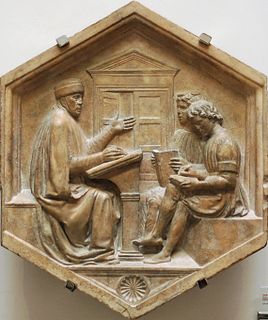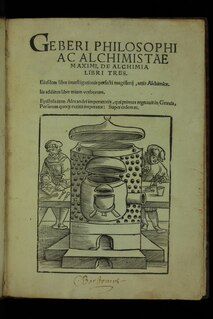Related Research Articles

Jordanes, also written as Jordanis or Jornandes, was a 6th-century Eastern Roman bureaucrat widely believed to be of Gothic descent who became a historian later in life. Late in life he wrote two works, one on Roman history (Romana) and the other on the Goths (Getica). The latter, along with Isidore of Seville's Historia Gothorum, is one of only two extant ancient works dealing with the early history of the Goths.

The Second Council of Constantinople is the fifth of the first seven ecumenical councils recognized by both the Eastern Orthodox Church and the Catholic Church. It is also recognized by the Old Catholics and others. Protestant opinions and recognition of it are varied. Some Protestants, such as Calvinists, recognize the first four councils, whereas Lutherans and most Anglo-Catholics accept all seven. Constantinople II was convoked by the Byzantine Emperor Justinian I under the presidency of Patriarch Eutychius of Constantinople. It was held from 5 May to 2 June 553. Participants were overwhelmingly Eastern bishops—only sixteen Western bishops were present, including nine from Illyricum and seven from Africa, but none from Italy—out of the 152 total.
Pope Vigilius was the bishop of Rome from 29 March 537 to his death. He is considered the first pope of the Byzantine papacy. Born into Roman aristocracy, Vigilius served as a deacon and papal apocrisiarius in Constantinople. He allied with Empress Theodora, who sought his help to establish Monophysitism, and was made pope after the deposition of Silverius. After he refused to sign Emperor Justinian I's edict condemning the Three Chapters, Vigilius was arrested in 545 and taken to Constantinople. He died in Sicily while returning to Rome.

Priscianus Caesariensis, commonly known as Priscian, was a Latin grammarian and the author of the Institutes of Grammar, which was the standard textbook for the study of Latin during the Middle Ages. It also provided the raw material for the field of speculative grammar.
Nonius Marcellus was a Roman grammarian of the 4th or 5th century AD. His only surviving work is the De compendiosa doctrina, a dictionary or encyclopedia in 20 books that shows his interests in antiquarianism and Latin literature from Plautus to Apuleius. Nonius may have come from Africa.
Marcus Terentius Varro was a Roman polymath and a prolific author. He is regarded as ancient Rome's greatest scholar, and was described by Petrarch as "the third great light of Rome". He is sometimes called Varro Reatinus to distinguish him from his younger contemporary Varro Atacinus.

Medieval literature is a broad subject, encompassing essentially all written works available in Europe and beyond during the Middle Ages. The literature of this time was composed of religious writings as well as secular works. Just as in modern literature, it is a complex and rich field of study, from the utterly sacred to the exuberantly profane, touching all points in-between. Works of literature are often grouped by place of origin, language, and genre.
The Three-Chapter Controversy, a phase in the Chalcedonian controversy, was an attempt to reconcile the non-Chalcedonians of Syria and Egypt with Chalcedonian Christianity, following the failure of the Henotikon. The Three Chapters that Emperor Justinian I anathematized were:
- The person and writings of Theodore of Mopsuestia
- Certain writings of Theodoret of Cyrus
- The letter of Ibas of Edessa to Maris

Pseudo-Geber is the presumed author or group of authors responsible for a corpus of pseudepigraphic alchemical writings dating to the late 13th and early 14th centuries. These writings were falsely attributed to Jabir ibn Hayyan, an early alchemist of the Islamic Golden Age.
Arator was a sixth-century Christian poet from Liguria in northwestern Italy. His best known work, De Actibus Apostolorum, is a verse history of the Apostles.
Latin American literature consists of the oral and written literature of Latin America in several languages, particularly in Spanish, Portuguese, and the indigenous languages of the Americas. It rose to particular prominence globally during the second half of the 20th century, largely due to the international success of the style known as magical realism. As such, the region's literature is often associated solely with this style, with the 20th century literary movement known as Latin American Boom, and with its most famous exponent, Gabriel García Márquez. Latin American literature has a rich and complex tradition of literary production that dates back many centuries.

Prefaces is a book by Søren Kierkegaard published under the pseudonym Nicolaus Notabene. The meaning of the pseudonym used for Prefaces, Nicholaus Notabene, was best summed up in his work Writing Sampler, where Kierkegaard said twice for emphasis, “Please read the following preface, because it contains things of the utmost importance.” He was trying to tell his critics to read the preface to his books because they have the key to understanding them. Nota bene is Latin for "note well".
Verecundus was a 6th-century writer and the bishop of Iunca in Roman North Africa. He was an ardent champion of the Three Chapters.
Primasius was bishop of Hadrumetum and primate of Byzacena, in Africa. One of the participants in the Three Chapters Controversy, his commentary on the Book of Revelation is of interest to modern scholars for its use of the lost commentary of Ticonius on the same book of the New Testament. According to M.L.W. Laistner, his disciples included the African theologian Junillus.

Pseudo-Cyprian is the conventional designation for the anonymous authors of Latin works falsely attributed to Cyprian of Carthage. These works do not have a common transmission history. Most are not forgeries, but were texts mistakenly attributed to Cyprian from an early date in their transmission. In many cases the works were taken to be authentic until modern times.

The Church Fathers, Early Church Fathers, Christian Fathers, or Fathers of the Church were ancient and influential Christian theologians and writers who established the intellectual and doctrinal foundations of Christianity. The historical period in which they worked became known as the Patristic Era and spans approximately from the late 1st to mid-8th centuries, flourishing in particular during the 4th and 5th centuries, when Christianity was in the process of establishing itself as the state church of the Roman Empire.
The Dialogue of Jason and Papiscus is a lost early Christian text in Greek describing the dialogue of a converted Jew, Jason, and an Alexandrian Jew, Papiscus. The text is first mentioned, critically, in the True Account of the anti-Christian writer Celsus, and therefore would have been contemporary with the surviving, and much more famous, Dialogue between the convert from paganism Justin Martyr and Trypho the Jew.

Vigilius is an extinct genus of brachyopid temnospondyl amphibian from the Triassic of Arizona. It is known from the single type species Vigilius wellesi.
Vigilius of Thapsus also known as Vigilius Tapsensis, Vigilius Afer, or Vergil of Tapso, was a 5th-century Bishop of Thapsus in the province Byzacium, in what is now Tunisia, and as well as a theological writer and polemicist.
Against Varimadus the Arian is an anonymous Nicene theological handbook against the Homoian heresy, written in Latin in a polemical style between 439 and 484. It is in the literary form of testimonia (testimonies), which the reader is supposed to be able to use to respond to Homoian adversaries. It belongs to the genre of heresiology, which was used to define orthodoxy and heresy.